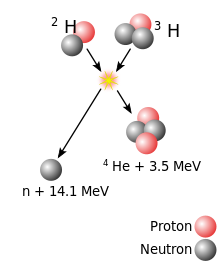Tennessine
The discovery of tennessine was officially announced in Dubna, Russia, by a Russian–American collaboration in April 2010, which makes it the most recently discovered element.
A few key properties, such as its melting and boiling points and its first ionization energy, are nevertheless expected to follow the periodic trends of the halogens.
[21] The definition by the IUPAC/IUPAP Joint Working Party (JWP) states that a chemical element can only be recognized as discovered if a nucleus of it has not decayed within 10−14 seconds.
[m] In December 2004, the Joint Institute for Nuclear Research (JINR) team in Dubna, Moscow Oblast, Russia, proposed a joint experiment with the Oak Ridge National Laboratory (ORNL) in Oak Ridge, Tennessee, United States, to synthesize element 117 — so called for the 117 protons in its nucleus.
Also in attendance were representatives of Lawrence Livermore National Laboratory, who had previously worked with JINR on the discovery of elements 113–116 and 118, and Joseph Hamilton of Vanderbilt University, a collaborator of Oganessian.
[58] Hamilton checked if the ORNL high-flux reactor produced californium for a commercial order: The required berkelium could be obtained as a by-product.
[60] During a September 2008 symposium at Vanderbilt University in Nashville, Tennessee, celebrating his 50th year on the Physics faculty, Hamilton introduced Oganessian to James Roberto (then the deputy director for science and technology at ORNL).
[56] Clarice Phelps was part of ORNL's team that collaborated with JINR;[62] this is particularly notable as because of it the IUPAC recognizes her as the first African-American woman to be involved with the discovery of a chemical element.
[67] The production lasted 250 days and ended in late December 2008,[68] resulting in 22 milligrams of berkelium, enough to perform the experiment.
Because of this, the berkelium target had to be quickly transported to Russia; for the experiment to be viable, it had to be completed within six months of its departure from the United States.
[56] On its arrival in Russia in June 2009, the berkelium was immediately transferred to Research Institute of Atomic Reactors (RIAR) in Dimitrovgrad, Ulyanovsk Oblast, where it was deposited as a 300-nanometer-thin layer on a titanium film.
[69] The calcium-48 beam was generated by chemically extracting the small quantities of calcium-48 present in naturally occurring calcium, enriching it 500 times.
[71] On 9 April 2010, an official report was released in the journal Physical Review Letters identifying the isotopes as 294117 and 293117, which were shown to have half-lives on the order of tens or hundreds of milliseconds.
[citation needed] In May 2014, a joint German–American collaboration of scientists from the ORNL and the GSI Helmholtz Center for Heavy Ion Research in Darmstadt, Hessen, Germany, claimed to have confirmed discovery of the element.
The decay chains assigned to 289115, the isotope instrumental in the confirmation of the syntheses of elements 115 and 117, were found based on a new statistical method to be too different to belong to the same nuclide with a reasonably high probability.
The reported 293117 decay chains approved as such by the JWP were found to require splitting into individual data sets assigned to different isotopes of element 117.
The multiplicity of states found when nuclides that are not even–even undergo alpha decay is not unexpected and contributes to the lack of clarity in the cross-reactions.
[84] After the original synthesis in 2010, Dawn Shaughnessy of LLNL and Oganessian declared that naming was a sensitive question, and it was avoided as far as possible.
[85] However, Hamilton, who teaches at Vanderbilt University in Nashville, Tennessee, declared that year, "I was crucial in getting the group together and in getting the 249Bk target essential for the discovery.
"[72] In a 2015 interview, Oganessian, after telling the story of the experiment, said, "and the Americans named this a tour de force, they had demonstrated they could do [this] with no margin for error.
[90] This is because of the ever-increasing Coulomb repulsion of protons, so that the strong nuclear force cannot hold the nucleus together against spontaneous fission for long.
[91] However, researchers in the 1960s suggested that the closed nuclear shells around 114 protons and 184 neutrons should counteract this instability, creating an "island of stability" where nuclides could have half-lives reaching thousands or millions of years.
[102] Tennessine is expected to be a member of group 17 in the periodic table, below the five halogens; fluorine, chlorine, bromine, iodine, and astatine, each of which has seven valence electrons with a configuration of ns2np5.
[105] Calculations have confirmed the accuracy of this simple extrapolation, although experimental verification of this is currently impossible as the half-lives of the known tennessine isotopes are too short.
[105] Significant differences between tennessine and the previous halogens are likely to arise, largely due to spin–orbit interaction—the mutual interaction between the motion and spin of electrons.
Computational chemists understand the split as a change of the second (azimuthal) quantum number l from 1 to 1/2 and 3/2 for the more-stabilized and less-stabilized parts of the 7p subshell, respectively.
Tennessine's first ionization energy—the energy required to remove an electron from a neutral atom—is predicted to be 7.7 eV, lower than those of the halogens, again following the trend.
[124] The molecule thus follows the trend for halogen hydrides, showing an increase in bond length and a decrease in dissociation energy compared to AtH.
[4] The molecules TlTs and NhTs may be viewed analogously, taking into account an opposite effect shown by the fact that the element's p1/2 electrons are stabilized.
[123] The TsF3 molecule is predicted to be significantly stabilized by spin–orbit interactions; a possible rationale may be the large difference in electronegativity between tennessine and fluorine, giving the bond a partially ionic character.






